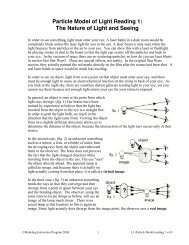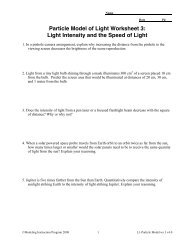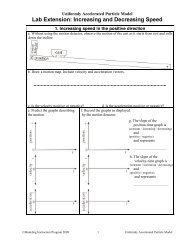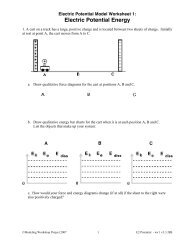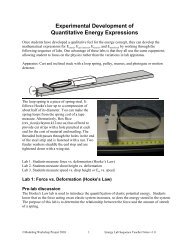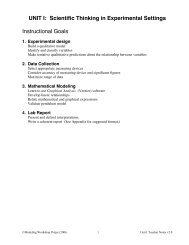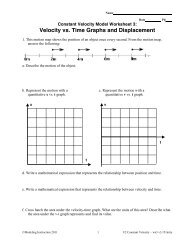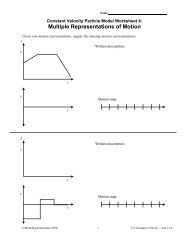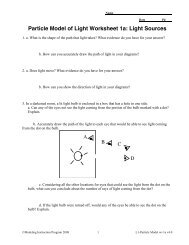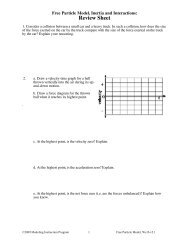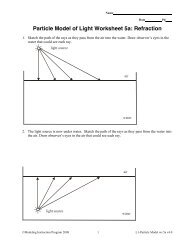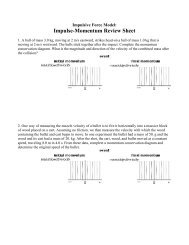Lab 1 - Modeling Physics
Lab 1 - Modeling Physics
Lab 1 - Modeling Physics
- No tags were found...
Create successful ePaper yourself
Turn your PDF publications into a flip-book with our unique Google optimized e-Paper software.
Electric Circuits Model <strong>Lab</strong> 1:What Happens in the Wires?Part I: THE CAPACITOR1. Charge the capacitor by briefly connecting it to the battery pack. For consistency, connect the“+” post (B) on the capacitor to the “+” terminal of the battery, and the "-" post (A) to the “-“terminal of the battery (see figure 1a).2. The charged capacitor and the two wires are shown in figure 1b above. Use the voltmeter tolook for evidence of an electric field between points in the circuit. When measuring changes inpotential, place the BLACK probe on the first lettered point and the RED probe on the secondlettered point. If you get a “zero” reading, try a more sensitive scale (millivolts instead of volts).AB B C C D D A _________3. What do positive vs. negative voltmeter readings tell you about the electric potential in segmentsof the circuit?4. In which segments do you find evidence of an electric field? How do the fields compare instrength and direction?©<strong>Modeling</strong> Workshop Project 2007 1 E3-Circuits - lab 1 v3.3 JBS
5. Sketch the charge distribution and field lines for the system with a charged capacitor.Capacitor6. Open the Logger Pro Template “Capacitor Discharge.” Charge the capacitor, connect the voltageprobes across the poles of the charged capacitor (red lead to B, black lead to A), and startcollecting data. You should see a horizontal line ≈ 4.5 V. Start the data collection again andwatch carefully as you touch the ends of the wires (C and D) together.a. Zoom in on the portion of the curve in which thepotential is changing.Vb. On the graph axes, sketch a graph of potential fromA to B vs. time during the discharge of thecapacitor. Include values on both axes.c. What happened to the electric field between A andB? How much time did this take?7. Recharge the capacitor, and connect the voltage probes across a connecting wire from B (black)to C (red). Start the data collection again and watch carefully as you touch the ends of the wires(C and D) together.a. Zoom in on the portion of the curve in which thepotential is changing.Vtb. On the graph above right, sketch a graph ofpotential from B to C vs. time during the dischargeof the capacitor. Include values on both axes.tc. What happened to the electric field between B andC? How much time did this take?©<strong>Modeling</strong> Workshop Project 2007 2 E3-Circuits - lab 1 v3.3 JBS
d. On the left diagram below, sketch the charge distribution and field lines when the potentialdifference between B and C is greatest. Below right, sketch the charge distribution and fieldlines when the potential difference returns to zero.Part II: THE CAPACITOR AND THE BULB1. Put a long light bulb in a socket. Connect C and D to the batteryand charge the capacitor. Connect D to the bulb holder. Connectthe voltage probes across the poles of the charged capacitor (redlead to B, black lead to A).a. Start collecting data and monitor the change in potential and bulbbrightness as you connect C to the bulb holder.b. Examine the graph of potential as a function of time for this event.What happened to the electric field through the light bulb? Howmuch time did this take?c. How does the time for the field to disappear in the circuit with the light bulb compare to yourprior observations without a light bulb in the circuit?2. From the “Experiment” menu, choose “Store Latest Run” so that you can record anotherexperiment on the same graph. Repeat the experiment, this time using a round bulb instead of along one. Print a graph of potential vs. time for both events on the same graph. How does thetime for the field to disappear with the round bulb compare to that for the long bulb?©<strong>Modeling</strong> Workshop Project 2007 3 E3-Circuits - lab 1 v3.3 JBS
3. With the round bulb in the holder, charge the capacitor,then connect the leads of the voltage probe to the wireends (black to C, red to D). Connect D to the bulb holder.Start collecting data and monitor the change in potentialand bulb brightness as you connect C to the bulb holder.Zoom in and sketch your graph of potential vs. time.Explain any differences compared to the graph obtained instep 2.Vt4. Use a stereo microscope to compare the thickness of the filaments in the long bulb and in theround bulb.a. Describe the differences between the filaments.b. In the diagrams below, draw how the difference in the filaments affects the way each bulbconnects points C and D. Your diagram should help to explain the difference in the dischargerates while representing the differences between each bulb and the connecting wires.BABACDlong bulbC Dround bulbc. Explain what you think happened to the distribution of charge during the time the bulbs werelit. Pay special attention to the region around C and D and contrast the differences betweenthe round and long bulbs.©<strong>Modeling</strong> Workshop Project 2007 4 E3-Circuits - lab 1 v3.3 JBS




